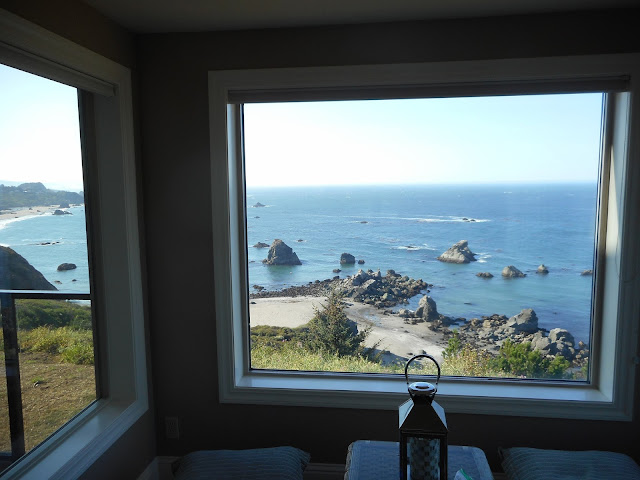THE absolute best, No. 1, superior view on the Oregon Coast, available for public lodging is at Rainbow Rock, 3 miles north of Brookings.
I stayed here for 5 days in August of 2015. Having traveled on vacations along the Oregon Coast some 24 times in the past 32 years, I've seen the majority of what's out there -- and the place called Toby's Crab Shack is light years ahead of the rest.
Case in point: My 19-year-old son has always turned the TV on and plopped down on a chair whenever we've stayed anywhere else.
The 2 indoor window seats at Toby's Crab Shack. There's a deck too.
However, at Toby's Crab Shack, he went to the window and sat down and starred. He never ate at the dinner table -- he took his food to the deck or the window chairs.
Now I have not idea why the name Toby's Crab Shack was given to this place. It should be called "The Room with THE view."
You will NEVER want to close the blinds at this place -- just keep the view always open.
Toby's Crab Shack is in the building on the left, second floor, far left (or north end) in these two photographs with a 180-degree clear view of the Pacific Ocean and rocky headlands galore.
Besides the spectacular view, the place has access to a private trail to a remote beach north of Brookings. It also has elaborate accommodations for 4 people (2 bedrooms) and is very affordable when you consider how much plain motels cost along the Oregon Coast.
Now, I'm not paid, affiliated or compensated in any way with or by Toby's Crab Shack. I just think it is a great place to stay and it has redefined my formula for lodging along the Oregon Coast.
The ONLY improvement I'd make in the place is to have a good spotting scope available by the window.
I will return to this place in the future. It is a gem.
Toby's is part of the large complex of condos at Rainbow Rock. It has a locked car gate and is its own private community. It is a very quiet, serene and well kept place.
-If you'd like to look at Toby's Crab Shack as a rental, go to VRBO.com and search for:
Oceanfront Condo in Brookings at Rainbow Rock
(NOTE: However, children are not allowed at Toby's Crab Shack. Yet, there is another condo for rent by the same company at the south end of Rainbow Rock that caters to families with young children.)
What the beach below Toby's Crab Shack is like ... My family members were often the only people there, even on a warm summer day.








.jpg)
.jpg)
.jpg)
.jpg)
.jpg)
.jpg)
.jpg)
.jpg)
.jpg)
.jpg)
.jpg)
+Day+3+(14).JPG)
+Day+3+(6).JPG)
+Day+3+(4).JPG)
.jpg)
.jpg)
.jpg)
.jpg)
.jpg)
.jpg)
.jpg)

.jpg)
.jpg)
.jpg)
.jpg)
.jpg)
.jpg)
.jpg)
.jpg)
.jpg)
.jpg)
.jpg)
.jpg)
.jpg)
